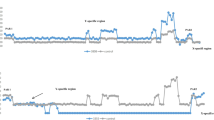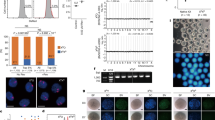Summary
In the onion fly, Delia antiqua. a fertile, Y-linked translocation involving chromosomes Y and 2 was irradiated with fast neutrons to induce new complexes involving the Y-chromosome. This chromosome is male determining in the onion fly. Such complexes can be used for the development of genetic sexing systems and also for the introduction of sterility into field populations following release.
Irradiation reduced egg fertility by 54 per cent and significantly reduced larval survival but it had no effect on the F1 sex ratio. By measuring the fertility of 807 F1 males following outcrossing, 112 semi-sterile progenies were isolated of which 11 were lost, 29 showed no inheritance of the semi-sterility, 59 were new autosomal translocations and 13 were new complex Y-linked translocations. This classification was accomplished by checking the fertilities of outcrossed F2 males and females. Following cytological observation it was revealed that one of these new complexes involved four chromosome pairs, the remainder involved three. There appeared to be no correlation between the fertility of the translocation and the complexity of the rearrangement. The utilization of these rearrangements in the development of the genetic sexing technique for the onion fly is discussed, together with an assessment of their use for fertility reduction in natural populations.
Similar content being viewed by others
Article PDF
References
Baker, R H, Sakai, R K, Saifuddin, U T, and Perveen, A. 1978. Induced chromosomal aberration in Anopheles culicifacies. Mosquito News, 38, 370–376.
Curtis, C F. 1975. Male-linked translocations and the control of insect pest populations. Experientia, 31, 1139–1140.
Curtis, C F. 1978. Genetic sexing separation in Anopheles arabiensis and the production of sterile hybrids. Bull WHO, 56, 453–456.
Curtis, C F, Akiyama, J, and Davidson, G. 1976. A genetic sexing system in Anopheles gambiae species. A Mos News 36, 492–496.
Van Heemert, C, and Robinson, A S. 1981. Cytogenetic analysis and break point distribution of radiation induced interchanges in Hylemya antiqua. Submitted to Genetica.
Van Heemert, C, and Vosselman, L. 1979. A male linked translocation with high fertility in the onion fly, Hylemya antiqua. Genetica, 51, 111–114.
Van Heemert, C, and Witteveen-Pillen, I. 1980. Location of the alcohol dehydrogenase gene in the onion fly Hylemya antiqua (Meigen) using a translocation in a tester set. J Hered, 71, 364–365.
Laven, H. 1969. Eradicating mosquitoes using translocations. Nature, 221, 958–959.
Laven, H, Cousserans, J, and Guille, G. 1972. Eradicating mosquitoes using translocations: A first field experiment. Nature, 236, 456–457.
McDonald, P T, Asman, S M, and Terwedow, H A. 1978. Sex linked translocations in Culex tarsalis: chromosome-linkage group correlation and segregation patterns. J Hered, 69, 304–310.
Muller, M J, and Altenberg, E. 1930. The frequency of translocations produced by X-rays in Drosophila. Genetics, 15, 283–311.
Rabbani, M G, and Kitzmiller, J B. 1975a. Studies on X-ray induced chromosomal translocations in A. albimanus. I. Chromosomal translocations and genetic control. Am J Trop Med Hyg, 24, 1019–1026.
Rabbani, M G, and Kitzmiller, J B. 1975b. Studies on X-ray induced chromosomal translocations in Anopheles albimanus. II. Laboratory evaluation of sexual competitiveness of translocation males. Am J Trop Med Hyg, 24, 1027–1030.
Robinson, A S. 1976. Production of chromosomal rearrangements by X-rays and fast neutrons in Hylemya antiqua in relation to genetic control. In The Use of Ionizing Radiation in Agriculture, pp. 345–350. C.E.E. Workshop Wageningen.
Robinson, A S. 1977. Genetic control of Hylemya antiqua. I. X-ray induced effects in the F0 and F1 generations. Mut Res, 42, 79–88.
Robinson, A S, and Van Heemert, C. 1980a. Translocations induced by fast neutrons and X-rays in Delia antiqua. Submitted to Theoret Appl Genet.
Robinson, A S, and Van Heemert, C. 1980b. Genetic sexing in Drosophila melanogaster using the alcohol dehydrogenase locus and a Y-linked translocation. Theoret Appl Genet In press.
Seawright, J A, Haile, D G, Rabbani, M G, and Weidhaas, D E. 1979. Computer simulation of the effectiveness of male linked translocation for the control of Anopheles albimanus. Am J Trop Med Hyg, 28, 155–160.
Seawright, J A, Kaiser, P E, Dame, D A, and Lofgren, C S. 1978. Genetic method for preferential elimination of females of Anopheles albimanus. Science, 200, 1303–1304.
Smith, R H, and Von Borstel, R C. 1972. Genetic control of insect populations. Science, 178, 1164–1174.
Towgood, J G, and Brown, A W A. 1962. Inheritance of dieldrin resistance in the onion maggot. Can J Genet Cytol, 4, 160–171.
Von Borstel, R C, and Rekemeyer, M L. 1959. Radiation induced and genetically contrived dominant lethality in Habrobracon and Drosophila. Genetics, 44, 1053–1074.
Wagoner, D E, Nickel, C A, and Johnson, D A. 1969. Chromosomal translocation heterozygotes in the house fly. J Hered, 60, 301–304.
Whitten, M J, Foster, G C, Vogt, W G, Kitching, R L, Woodburn, T L, and Konovalov, C. 1976. Current status of genetic control of the Australian sheep blowfly, Lucilia cuprina. Prox XV Intern Congr Entomol, pp. 129–239. Washington D.C.
Author information
Authors and Affiliations
Rights and permissions
About this article
Cite this article
Robinson, A., van Heemert, K. Complex Y-linked translocations in Delia antiqua produced by irradiation of a fertile Y-linked translocation. Heredity 46, 41–48 (1981). https://doi.org/10.1038/hdy.1981.4
Received:
Issue date:
DOI: https://doi.org/10.1038/hdy.1981.4



